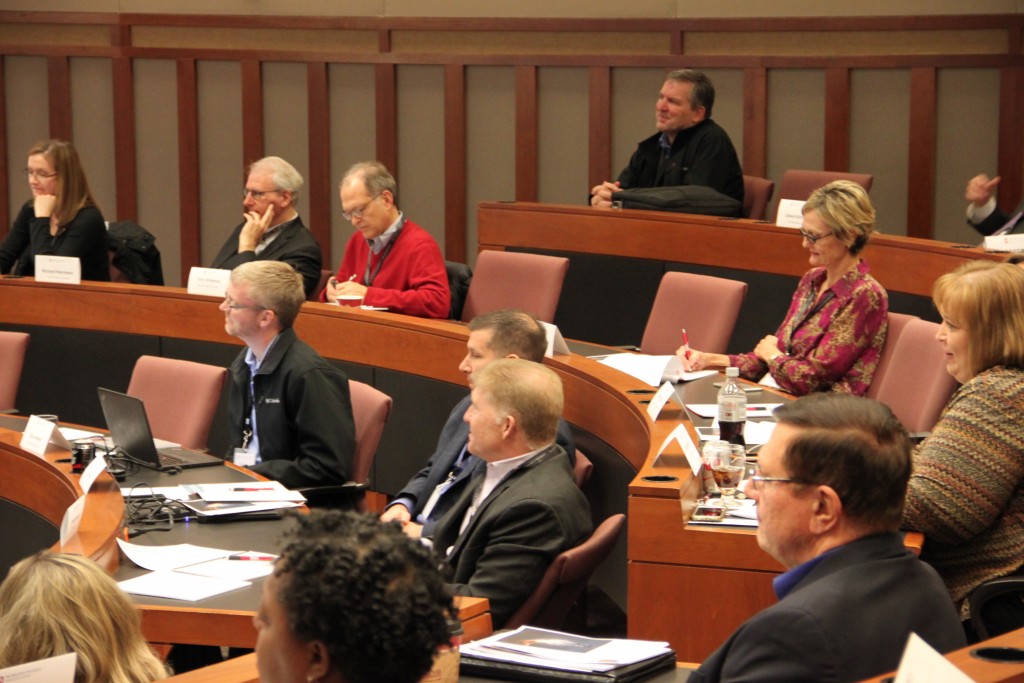In response to what seems to be evolving as the new normal, Ohio State’s Risk Institute at the Fisher College of Business, in partnership with representatives from the insurance industry, found an innovative way of discussing some of the pertinent questions surrounding COVID-19’s impact on business with over 300 listeners through a virtual webinar on Zoom, May 13, 2020.
Three experts from the insurance field, Dean Fadel, President of the Ohio Insurance Institute, Joseph Petrelli, President of Demotech, and insurance industry attorney Kirk Pasich of Pasich LLP collaborated with Philip Renaud, Executive Director of the Risk Institute, to talk about business interruption and the impact of COVID-19 from the insurer and policyholder perspectives. Specifically:
- The dynamics of what is happening across the country and how various jurisdictions are interpreting coverage or lack thereof.
- Does revenue loss due to supply chain problems and business shutdowns by government directives trigger coverage? (Either direct business interruption losses, or contingent, resulting from a supply chain’s inability to provide good or services).
- How underwriters and actuaries looked at pandemic clauses and the risks associated with policies were originally written compared to today.
Dean Fadel believes that the insurance industry so far has been good corporate citizens. For customers, auto insurers have returned $10.5 billion to date through premium relief. For employees, many insurers are pledging no layoffs during the ongoing crisis. That said, the insurance industry as a whole will begin to see an increase in claims and a decrease in premium revenue moving forward.
One area relevant for insurers to consider given the current climate is business interruption insurance. Legislation is currently being discussed or introduced in eight states, including Washington D.C., thus far. These potential changes would retroactively enact business interruption coverage into existing policies — despite an absence of the physical damage required in property policies, and/or express exclusions for communicable diseases in those policies.
It is estimated that 40% overall and less than 30% of small commercial consumers purchase business interruption insurance. Mandating business interruption payouts would cost insurers at least $255 billion per month. Meaning, in three months the industry’s nearly $800 billion surplus would be depleted. Moving forward, companies need to not ask “what can I afford?” but rather “what did I sell this customer and what are my responsibilities under that policy?”
Joe Petrelli, President of Demotech, reiterates the fact that the insurance industry as a whole is not made up of just “the giants.” Out of 11 different insurance business models, the overwhelming majority are small companies (52% operate in one state or in one particular line of insurance). These companies will be waiting to hear about decisions made in that line of insurance or the decisions made in their particular state of operation.
The National Association of Insurance Commissioners (NAIC) have issued their own discussion for the federal government to consider. The Association thinks it’s inappropriate to ask for retroactive business interruption coverage and argue these companies should not have to “step up” just because they may have the financial wherewithal to do so.
The final speaker at the Risk Institute’s virtual webinar was insurance industry attorney Kirk Pasich of Pasich LLP, who began by touching on the relevancy of the distinction between a “virus” and a “disease.” For the record: the disease (coronavirus/COVID-19) causes the virus (Severe acute respiratory syndrome coronavirus two (SARS-CoV-2).
Some policies have exclusions for viruses, others have exclusions for communicable diseases. The baseline is that claims come because the spread of the virus can cause the disease. COVID-19 itself is not communicable, but the virus is. Therefore, the closings are to stop the virus. This begs the question, Is there physical loss or damage to property?
Pasich highlights the fact that insurers are likely to argue that the introduction of a virus does not constitute direct physical loss or damage to insured property nor is it a covered peril. This reality is reflected in a letter written March 18 by industry insiders:
“Business interruption policies do not, and were not designed to, provide coverage against communicable diseases such as COVID-19.”
-March 18, 2020, letter, National Association of Mutual Insurance Companies, Independent Insurance Agents & Brokers of America, Council of Insurance Agents and Brokers, and American Property Casualty Insurance Association, to House Committee on Business.
According to Pasich, it depends on the policy language and what jurisdiction the company is in. Courts in individual jurisdictions will be responsible for interpreting that language amidst the current pandemic.
Furthermore, most insurers did not include virus/pandemic exclusions in their policies, despite knowledge of the potential threat since the early 2000s. If an insurance company elected not to use an available, standard, industry-wide exclusion then it can be held accountable for that, Pasich argues. He says there have been many warnings over the last 20 years about this risk and that the industry knew it was coming. It was a question of when not if.
In closing, Pasich reiterates that he doesn’t support changes in state law to force insurance companies to insure what they didn’t assume. But at the same time, those companies shouldn’t be able to walk away from the risk that they knowingly assumed.
The Risk Institute will be sponsoring more virtual webinars in the coming months on topics important to the industry, Risk Institute members, and the community at large. Registration is now open.
As Executive Director Philip Renaud highlights in his closing remarks:
“Be safe, stay well, and follow the CDC orders to wash hands, sanitize, and social distance as we move forward.”
Written by: Jack Delahunty, in partnership with the Risk Institute at The Ohio State University







